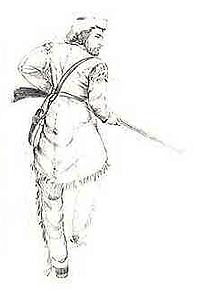|
remains as to how the cave came to the attention of Europeans. According to legend, at the turn of the 19th Century a man named John Houchins, out hunting, found a black bear close by the entrance of the cave, and shot it. He failed, however, to kill the bear outright (some locals interpret this lapse to mean that Houchins “couldn’t have been a Kentuckian”) and chased it until it led him to the cave entrance. The legend tapers off at this point, leaving unanswered the question of whether Houchins ever got his bear, but whether or not, Houchins gained the credit of the modern discovery of the great cave. The exact date, however, is confused, some accounts relating the discovery in 1798, some in 1802. There is a record of the lands about the cave listed in the Warren County Survey Book, 1796-1815, which relates that “Valentine Simon enters 200 acres of second rate land in Warren County by virtue of the Commissioner’s Certificate No. 2428 lying on Green River begining on a sycamore tree on the bank of said River thence running southward including two peter caves, thence angling down said river for quantity to include the improvement.” The two “petre caves” were Dixon Cave and Mammoth Cave, and Simon is considered the cave’s first legal owner. Such matters of civil legality were only beginning to matter in Kentucky by the turn of the 19th century. Before 1775 the white population of Kentucky was principally hunters, and the peopling of the Mammoth Cave area did not truly commence until the arrival of settlers from Virginia and North Carolina around 1800. These people were mostly of Anglo-Saxon bloodlines, with such names as Cox, Holton, Coats, Shackleford, Ester, Vance and Slemmons, names which persist in the region today. These hardy settlers took up residence in the river bottoms and the sunken valleys. A colony of Swedes also settled nearby, as the modern towns of Sweden and Stockholm bear witness. |











